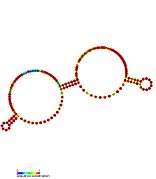HOTAIR
HOTAIR (for HOX transcript antisense RNA)[2] is a human gene located on chromosome 12. It is the first example of an RNA expressed on one chromosome that has been found to influence transcription on another chromosome.
Gene and transcribed RNA product
The HOTAIR gene contains 6,232 bp and encodes 2.2 kb long noncoding RNA molecule, which controls gene expression. Its source DNA is located within a HOXC gene cluster. It is shuttled from chromosome 12 to chromosome 2 by the Suz-Twelve protein.[3]
Function
The 5' end of HOTAIR interacts with a Polycomb-group protein Polycomb Repressive Complex 2 (PRC2) and as a result regulates chromatin state. It is required for gene-silencing of the HOXD locus by PRC2.[4][5] The 3' end of HOTAIR interacts with the histone demethylase LSD1.[5]
It is an important factor in the epigenetic differentiation of skin over the surface of the body. Skin from various anatomical positions is distinct, e.g. the skin of the eyelid differs markedly from that on the sole of the foot.[4][6]
Clinical significance
HOTAIR is highly expressed in metastatic breast cancers. High levels of expression in primary breast tumours are a significant predictor of subsequent metastasis and death.[7] It is also involved in esophageal squamous cell carcinoma.[8]
References
- ↑ "Human PubMed Reference:".
- ↑ "Genecards entry on HOTAIR". Retrieved 20 July 2010.
- ↑ Petherick A (Aug 2008). "Genetics: The production line". Nature. 454 (7208): 1042–5. doi:10.1038/4541042a. PMID 18756228.
- 1 2 Rinn JL, Kertesz M, Wang JK, Squazzo SL, Xu X, Brugmann SA, Goodnough LH, Helms JA, Farnham PJ, Segal E, Chang HY (Jun 2007). "Functional demarcation of active and silent chromatin domains in human HOX loci by noncoding RNAs". Cell. 129 (7): 1311–23. doi:10.1016/j.cell.2007.05.022. PMC 2084369
 . PMID 17604720.
. PMID 17604720. - 1 2 Tsai MC, Manor O, Wan Y, Mosammaparast N, Wang JK, Lan F, Shi Y, Segal E, Chang HY (Aug 2010). "Long noncoding RNA as modular scaffold of histone modification complexes". Science. 329 (5992): 689–93. doi:10.1126/science.1192002. PMC 2967777
 . PMID 20616235.
. PMID 20616235. - ↑ Chuong CM (Jan 2003). "Homeobox genes, fetal wound healing, and skin regional specificity". The Journal of Investigative Dermatology. 120 (1): 9–11. doi:10.1046/j.1523-1747.2003.00002.x. PMID 12535191.
- ↑ Gupta RA, Shah N, Wang KC, Kim J, Horlings HM, Wong DJ, Tsai MC, Hung T, Argani P, Rinn JL, Wang Y, Brzoska P, Kong B, Li R, West RB, van de Vijver MJ, Sukumar S, Chang HY (Apr 2010). "Long non-coding RNA HOTAIR reprograms chromatin state to promote cancer metastasis". Nature. 464 (7291): 1071–6. doi:10.1038/nature08975. PMC 3049919
 . PMID 20393566.
. PMID 20393566. - ↑ Chen FJ, Sun M, Li SQ, Wu QQ, Ji L, Liu ZL, Zhou GZ, Cao G, Jin L, Xie HW, Wang CM, Lv J, De W, Wu M, Cao XF (Nov 2013). "Upregulation of the long non-coding RNA HOTAIR promotes esophageal squamous cell carcinoma metastasis and poor prognosis". Molecular Carcinogenesis. 52 (11): 908–15. doi:10.1002/mc.21944. PMID 24151120.
Further reading
- Woo CJ, Kingston RE (Jun 2007). "HOTAIR lifts noncoding RNAs to new levels". Cell. 129 (7): 1257–9. doi:10.1016/j.cell.2007.06.014. PMID 17604716.
- Khalil AM, Guttman M, Huarte M, Garber M, Raj A, Rivea Morales D, Thomas K, Presser A, Bernstein BE, van Oudenaarden A, Regev A, Lander ES, Rinn JL (Jul 2009). "Many human large intergenic noncoding RNAs associate with chromatin-modifying complexes and affect gene expression". Proceedings of the National Academy of Sciences of the United States of America. 106 (28): 11667–72. doi:10.1073/pnas.0904715106. PMC 2704857
 . PMID 19571010.
. PMID 19571010.
- Wan Y, Chang HY (Sep 2010). "HOTAIR: Flight of noncoding RNAs in cancer metastasis". Cell Cycle. 9 (17): 3391–2. doi:10.4161/cc.9.17.13122. PMC 3066151
 . PMID 20864820.
. PMID 20864820.
- Hung T, Chang HY (September 2010). "Long noncoding RNA in genome regulation: prospects and mechanisms". RNA Biology. 7 (5): 582–5. doi:10.4161/rna.7.5.13216. PMC 3073254
 . PMID 20930520.
. PMID 20930520.
- Kaneko S, Li G, Son J, Xu CF, Margueron R, Neubert TA, Reinberg D (Dec 2010). "Phosphorylation of the PRC2 component Ezh2 is cell cycle-regulated and up-regulates its binding to ncRNA". Genes & Development. 24 (23): 2615–20. doi:10.1101/gad.1983810. PMC 2994035
 . PMID 21123648.
. PMID 21123648.
- Sun L, Fang J (Jan 2011). "Writer meets eraser in HOTAIR". Acta Biochimica et Biophysica Sinica. 43 (1): 1–3. doi:10.1093/abbs/gmq110. PMID 21138898.
- Yang Z, Zhou L, Wu LM, Lai MC, Xie HY, Zhang F, Zheng SS (May 2011). "Overexpression of long non-coding RNA HOTAIR predicts tumor recurrence in hepatocellular carcinoma patients following liver transplantation". Annals of Surgical Oncology. 18 (5): 1243–50. doi:10.1245/s10434-011-1581-y. PMID 21327457.
- Nie Y, Liu X, Qu S, Song E, Zou H, Gong C (Apr 2013). "Long non-coding RNA HOTAIR is an independent prognostic marker for nasopharyngeal carcinoma progression and survival". Cancer Science. 104 (4): 458–64. doi:10.1111/cas.12092. PMID 23281836.
External links
Gallery of HOTAIR conserved secondary structure images |
|---|
|
| HOTAIR_1: Secondary structure taken from the Rfam database. Family RF01904 |
| HOTAIR_2: Secondary structure taken from the Rfam database. Family RF01905 |
| HOTAIR_3: Secondary structure taken from the Rfam database. Family RF01906 |
| HOTAIR_4: Secondary structure taken from the Rfam database. Family RF01907 |
| HOTAIR_5: Secondary structure taken from the Rfam database. Family RF01908 |
|
|
 . PMID 17604720.
. PMID 17604720. . PMID 20616235.
. PMID 20616235. . PMID 20393566.
. PMID 20393566. . PMID 19571010.
. PMID 19571010. . PMID 20864820.
. PMID 20864820. . PMID 20930520.
. PMID 20930520. . PMID 21123648.
. PMID 21123648.



